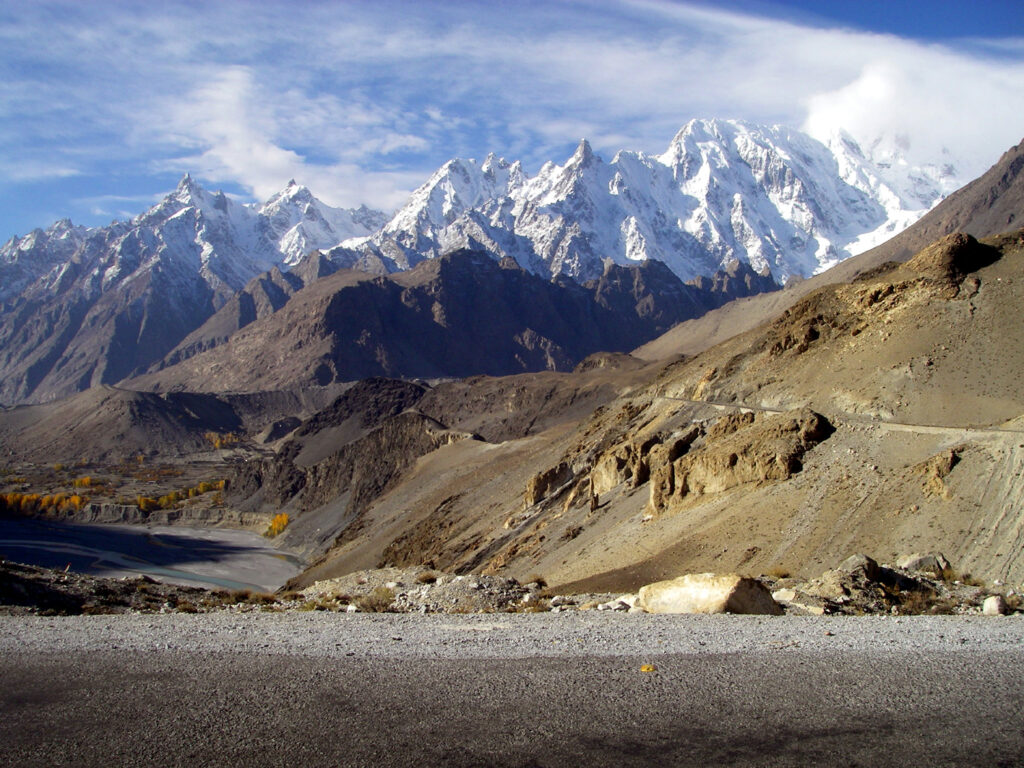What are the implications of recent changes to the Karakoram’s “glacier anomaly”?
Glaciers of the Karakoram have largely bucked global trends of declining ice mass, in part due to large-scale changes in regional atmospheric circulation patterns (Farinotti et al., 2020), though the complexity of this system creates high uncertainty in one single cause. These glaciers are increasingly being relied upon as a water resource owing to a growing population and an increased likelihood of drought as a result of climate change (Nie et al., 2021). However, the stability of Karakoram glaciers is becoming spatially heterogenous (Ougahi et al., 2022) and, in some watersheds, declining altogether (Xie et al., 2024). Due to a scarcity of on-the-ground observations, and other unusual dynamic features such as surging (Quincey et al., 2011), future projections of the water resource of this data-poor region are hugely variable.
As climate change accelerates the water resource challenges prevalent within the mountain cryosphere, a challenge exists in being able to robustly track these changes using observation and modelling methods and communicate these findings, as well as their inherent uncertainties, to non-scientific audiences such as community groups, who have unique cultural connections to glaciers and the wider mountain environment. This PhD will serve to combine a broad range of Geographical techniques in order to understand the physical mechanisms behind how glaciers of the Karakoram are changing, and the human impact of this change. The aim of this project, therefore, is to understand how changes to the Karakoram “anomaly” are reflected in water resource provision across the region.

Objectives
A key challenge for glaciologists working in the region is in understanding the dynamic nature of glacier evolution and how this corresponds to future mass change. Using a new generation of remote sensing techniques (Taylor et al., 2021) such as cloud computing and machine learning, this PhD will seek to apply high-resolution satellite archives (ICESat and ICESat-2) to quantify changes in mass loss across the entire Karakoram in unprecedented detail, and explore the factors contributing to this mass loss.
Second, the PhD will apply the findings from the changes in mass loss with hydrological models to understand when water stresses will occur across the Karakoram. This will seek to discover long-term (multi-decadal) projections for glaciers as water resources, as well as short-term (seasonal) changes to glacier-fed river flow across catchments of the Karakoram.
Finally, fieldwork in the region will help us to understand how communities are already responding to changes to water resources, and what adaptation mechanisms could work to minimise the impact of future changes to water resource.
Supervision
The supervisory team have a breadth of experience in monitoring and modelling of mountain glaciers globally, including in the Karakoram. We also try to work beyond traditional academic silos to ensure that we remain connected to communities who our science can help. The successful student will be based in the School of Geography and will benefit from a supportive and inclusive research community through our River Basins Processes and Management research cluster, water@leeds, as well as our postgraduate-led and interdisciplinary ‘Ice Club’.
The candidate
The successful candidate will work closely with local partners in regional government, industry, and with community leaders to generate remote sensing datasets that can support populations at the face of climate change. Such datasets will likely include a quantification of recent past glacial mass balance, projections of future glacier retreat, and availability of future water resource. Upscaling to a national (and even international) level will be achieved by using big data and cloud computing. During fieldwork in the Karakoram, the candidate should expect to work with local communities and partner organisations to disseminate PhD findings to a non-academic audience. No prior fieldwork experience is necessary, but experience that demonstrates an understanding of, or connection to, mountain or indigenous communities would be desirable.
Further Reading
Farinotti, D. et al. 2021. Manifestations and mechanisms of the Karakoram glacier anomaly. Nature Geoscience, 13.
Nie, Y. et al. 2021. Glacial change and hydrological implications in the Himalaya and Karakoram. Nature Reviews Earth & Environment, 2.
Ougahi, J.H. et al. 2022. Assessing the Karakoram Anomaly from long-term trends in earth observation and climate data. Remote Sensing Applications: Society and Environment, 28.
Quincey, D. et al. 2011. Karakoram glacier surge dynamics. Geophysical Research Letters, 38.
Taylor, L. et al. 2021. Remote sensing of the mountain cryosphere: Current capabilities and future opportunities for research. Progress in Physical Geography, 45.
Xie, F. et al. 2024. Retrieval of high-resolution melting-season albedo and its implications for the Karakoram Anomaly. Remote Sensing of Environment, 315.
